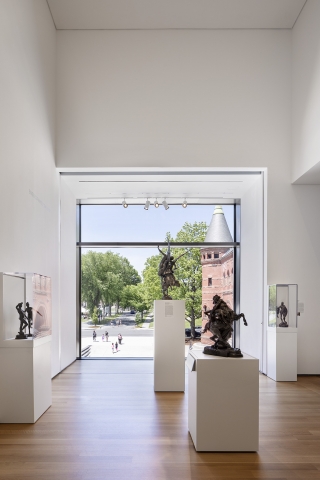
ABOVE Looking out over the Dartmouth Green from the Engles Gallery. Photo © Michael Moran
Emulating Antiquity: Nineteenth-Century European Sculpture
January 26, 2019, to February 16, 2020
Engles Family Gallery
Powerful ancient goddesses and heroic warriors populated this gallery of French, British, and American sculpture from the 19th century. Accompanied by Lawrence Alma Tadema's monumental painting The Sculpture Gallery from the mid-1870s—a treatise on the legacy of ancient Greek and Roman art—the works testified to the prominent place of figural sculpture at this time. The lenses through which we view this art have shifted in the last thirty years, prompting the exploration of themes from homoeroticism and sexuality to changing aesthetic ideals.
Munakata at Dartmouth
January 26 to March 26, 2019
Class of 1967 Gallery
Though recognized the world over for his woodblock prints, Shiko Munakata is widely regarded in Japan as one of the nation's foremost 20th-century calligraphers—an honor of considerable significance, for calligraphy has always been the highest form of art in East Asia. This installation highlighted works collecting during and since Munakata's time as a visiting artist and lecturer at Dartmouth in 1965. It also featured pairings of several works from Utagawa Hiroshige's (1797–1858) Tokaido with Munakata's revisiting of these sites.
Narratives in Japanese Woodblock Prints
March 27 to June 9, 2019
Class of 1967 Gallery
Japanese woodblock-print artists produced numerous rich engagements with culturally resonant narratives that were often loosely based on historical events, then subsequently embellished in textual sources and their theatrical adaptations. The artists featured in this exhibition explore a wide and often gendered range of responses to those narratives' emotionally charged moral and ethical dilemmas.
New Landscapes: Contemporary Responses to Globalization
June 15 to August 18, 2019
Class of 1967 Gallery
Humanity's unceasing consumption and development has had complex repercussions on the physical, social, and cultural landscapes around the world. Artists are actively engaging with the consequences of our impacts on the planet and, in response, considering alternative realities—from imagining a transformed landscape or a dystopian future in the wake of ecological disaster to inventing new worlds to escape the effects of industrialization. This exhibition of recent acquisitions reflected on the diversity of experiences in, responses to, and projections of our many lived and potential realities.